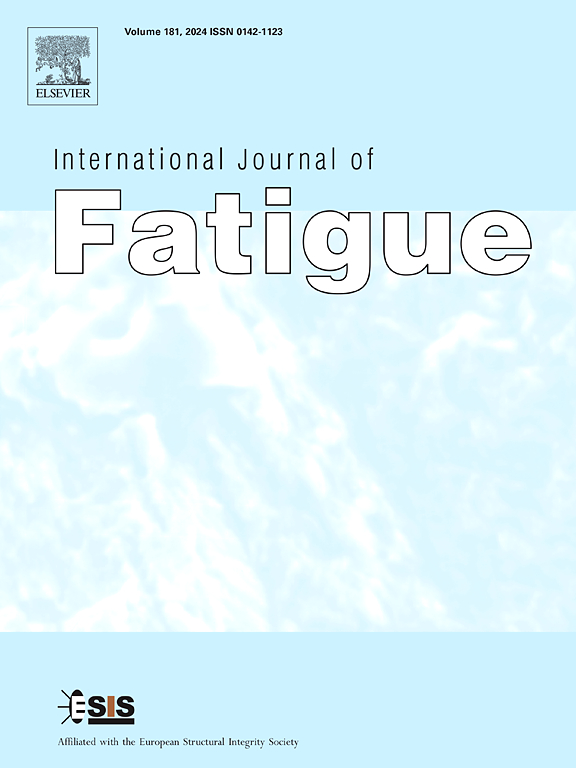Time-dependent fatigue reliability analysis of heavy-haul railway steel bridges based on coupled train-track-bridge dynamic analysis
IF 5.7
2区 材料科学
Q1 ENGINEERING, MECHANICAL
引用次数: 0
Abstract
Due to the severity and sudden onset of damage, fatigue failure in heavy-haul railway bridges has become a critical concern for all stakeholders. This study develops a comprehensive time-dependent fatigue reliability framework based on stress range analysis, where stress ranges, regarded as the primary drivers of fatigue damage, are systematically characterized for their stochastic and dynamic nature. The developed framework integrates three key innovations: (1) implementation of a coupled train-track-bridge system-based stochastic dynamic analysis, enhancing conventional static methods to more accurately characterize the dynamical development of the stress range; (2) development of a continuous nonstationary stochastic process model for the stress range that surpasses traditional stationary assumptions in realism; and (3) application of a fourth-moment transformation method for time-dependent reliability analysis involving nonstationary stochastic processes. The proposed framework is validated through application to an actual heavy-haul railway steel bridge, revealing that both the stress range and the fatigue limit state function exhibit time-dependent, nonstationary, and non-Gaussian characteristics. Notably, incorporating dynamic analysis under a nonstationary assumption proves to be critical, as conventional methods tend to overestimate fatigue reliability. This study provides valuable insights for engineers in the design, assessment, and management of railway bridges under stochastic fatigue loads.
基于列车-轨道-桥梁耦合动力分析的重载铁路钢桥时效疲劳可靠性分析
重载铁路桥梁的疲劳破坏由于其损伤的严重性和突发性,已成为各方关注的焦点。本研究建立了一个基于应力范围分析的综合时效疲劳可靠性框架,其中应力范围被视为疲劳损伤的主要驱动因素,系统地表征了其随机性和动态性。开发的框架集成了三个关键创新:(1)实现了基于列车-轨道-桥梁耦合系统的随机动力分析,改进了传统的静力学方法,以更准确地表征应力范围的动态发展;(2)建立了一个连续的非平稳随机过程模型,该模型在现实中超越了传统的平稳假设;(3)四矩变换方法在非平稳随机过程时变可靠性分析中的应用。通过实际重载铁路钢桥的应用验证了所提出的框架,表明应力范围和疲劳极限状态函数都具有时变、非平稳和非高斯特征。值得注意的是,在非平稳假设下进行动态分析被证明是至关重要的,因为传统方法往往会高估疲劳可靠性。本研究为铁路桥梁在随机疲劳荷载作用下的设计、评估和管理提供了有价值的见解。
本文章由计算机程序翻译,如有差异,请以英文原文为准。
求助全文
约1分钟内获得全文
求助全文
来源期刊

International Journal of Fatigue
工程技术-材料科学:综合
CiteScore
10.70
自引率
21.70%
发文量
619
审稿时长
58 days
期刊介绍:
Typical subjects discussed in International Journal of Fatigue address:
Novel fatigue testing and characterization methods (new kinds of fatigue tests, critical evaluation of existing methods, in situ measurement of fatigue degradation, non-contact field measurements)
Multiaxial fatigue and complex loading effects of materials and structures, exploring state-of-the-art concepts in degradation under cyclic loading
Fatigue in the very high cycle regime, including failure mode transitions from surface to subsurface, effects of surface treatment, processing, and loading conditions
Modeling (including degradation processes and related driving forces, multiscale/multi-resolution methods, computational hierarchical and concurrent methods for coupled component and material responses, novel methods for notch root analysis, fracture mechanics, damage mechanics, crack growth kinetics, life prediction and durability, and prediction of stochastic fatigue behavior reflecting microstructure and service conditions)
Models for early stages of fatigue crack formation and growth that explicitly consider microstructure and relevant materials science aspects
Understanding the influence or manufacturing and processing route on fatigue degradation, and embedding this understanding in more predictive schemes for mitigation and design against fatigue
Prognosis and damage state awareness (including sensors, monitoring, methodology, interactive control, accelerated methods, data interpretation)
Applications of technologies associated with fatigue and their implications for structural integrity and reliability. This includes issues related to design, operation and maintenance, i.e., life cycle engineering
Smart materials and structures that can sense and mitigate fatigue degradation
Fatigue of devices and structures at small scales, including effects of process route and surfaces/interfaces.
 求助内容:
求助内容: 应助结果提醒方式:
应助结果提醒方式:


